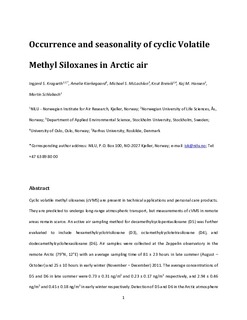Occurrence and seasonality of cyclic volatile methyl siloxanes in Arctic air
Krogseth, Ingjerd Sunde; Kierkegaard, Amelie; McLachlan, Michael S.; Breivik, Knut; Hansen, Kaj M.; Schlabach, Martin
Journal article, Peer reviewed
Accepted version
Date
2013Metadata
Show full item recordCollections
- Publikasjoner fra Cristin - NILU [1329]
- Vitenskapelige publikasjoner [1068]
Original version
Krogseth, I.S., Kierkegaard, A., Mclachlan, M.S., Breivik, K., Hansen, K.M., Schlabach, M. (2013). Occurrence and seasonality of cyclic volatile methyl siloxanes in Arctic air. Environmental Science and Technology, 47, 502-509. doi:10.1021/es3040208 10.1021/es3040208Abstract
Cyclic volatile methyl siloxanes (cVMS) are present in technical applications and personal care products. They are predicted to undergo long-range atmospheric transport, but measurements of cVMS in remote areas remain scarce. An active air sampling method for decamethylcyclopentasiloxane (D5) was further evaluated to include hexamethylcyclotrisiloxane (D3), octamethylcyclotetrasiloxane (D4), and dodecamethylcyclohexasiloxane (D6). Air samples were collected at the Zeppelin observatory in the remote Arctic (79° N, 12° E) with an average sampling time of 81 ± 23 h in late summer (August−October) and 25 ± 10 h in early winter (November−December) 2011. The average concentrations of D5 and D6 in late summer were 0.73 ± 0.31 and 0.23 ± 0.17 ng/m3, respectively, and 2.94 ± 0.46 and 0.45 ± 0.18 ng/m3 in early winter, respectively. Detection of D5 and D6 in the Arctic atmosphere confirms their long-range atmospheric transport. The D5 measurements agreed well with predictions from a Eulerian atmospheric chemistry−transport model, and seasonal variability was explained by the seasonality in the OH radical concentrations. These results extend our understanding of the atmospheric fate of D5 to high latitudes, but question the levels of D3 and D4 that have previously been measured at Zeppelin with passive air samplers.
